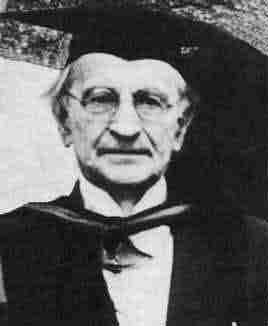<Back to Index>
- Logician and Philosopher Jan Łukasiewicz, 1878
PAGE SPONSOR



Jan Łukasiewicz (21 December 1878 – 13 February 1956) was a Polish logician and philosopher born in Lwów (Lemberg in German), Galicia, Austria – Hungary (now Lviv, Ukraine). His work centred on analytical philosophy and mathematical logic. He thought innovatively about traditional propositional logic, the principle of non - contradiction and the law of excluded middle.
He grew up in Lwów and was the only child of Paweł Łukasiewicz, a captain in the Austrian army, and Leopoldina (née Holtzer), the daughter of an Austrian civil servant. His family was Roman Catholic.
He finished his gymnasium studies in philology and in 1897 went on to Lwów University (University of Lemberg) where he studied philosophy and mathematics. In philosophy he was a pupil of Kazimierz Twardowski. In 1902, he received a Doctor of Philosophy degree under the patronage of emperor Franz Joseph I of Austria who gave him a special doctor ring with diamonds.
He spent three years as a private teacher, and in 1905 he received a scholarship to complete his philosophical studies at the University of Berlin and the University of Louvain in Belgium. Łukasiewicz continued studying for his habilitation qualification and in 1906 submitted his thesis to the University of Lwów. In 1906 he was appointed a lecturer at the University of Lwów where he was eventually appointed Extraordinary Professor by Emperor Franz Joseph I. He taught there until the First World War. In 1915 he was invited to lecture as a full professor at the University of Warsaw which had re-opened after being closed down by the Tsarist government in the 19th century.
In 1919 Łukasiewicz left the university to serve as Polish Minister of Religious Denominations and Public Education in the Paderewski government until 1920.
In 1928 he married Regina Barwińska.
He remained a professor at the University of Warsaw from 1920 until 1939 when the family house was destroyed by German bombs and the university was closed under German occupation. He had been a rector of the university twice. In this period Lukasiewicz and Stanisław Leśniewski founded the Lwów – Warsaw school of logic which was later made internationally famous by Alfred Tarski who had been Leśniewski's student.
At the beginning of World War II he worked at the Warsaw Underground University as part of the secret system of education in Poland during World War II. He and his wife wanted to move to Switzerland but could not get permission from the German authorities. Instead, in the summer of 1944, they left Poland with the help of Heinrich Scholz and spent the last few months of the war in Münster, Germany, hoping to somehow go on further, perhaps to Switzerland.
Following the war, he emigrated to Ireland and worked at the University College Dublin (UCD) until his death.
A number of axiomatizations of classical propositional logic are due to Łukasiewicz. A particularly elegant axiomatization features a mere three axioms and is still invoked down to the present day. He was a pioneer investigator of multi - valued logics; his three - valued propositional calculus, introduced in 1917, was the first explicitly axiomatized non - classical logical calculus. He wrote on the philosophy of science, and his approach to the making of scientific theories was similar to the thinking of Karl Popper.
Łukasiewicz invented the Polish notation (named after his nationality) for the logical connectives around 1920. In Łukasiewicz 1951 book, Aristotle's Syllogistic from the Standpoint of Modern Formal Logic, he mentions that the principle of his notation was to write the functors before the arguments to avoid brackets and that he had employed his notation in his logical papers since 1929. He then goes on to cite, as an example, a 1930 paper he wrote with Alfred Tarski on the sentential calculus.
This notation is the root of the idea of the recursive stack, a last - in, first - out computer memory store proposed by several researchers including Turing, Bauer and Hamblin, and first implemented in 1957. In 1960, Łukasiewicz notation concepts and stacks were used as the basis of the Burroughs B5000 computer designed by Robert S. Barton and his team at Burroughs Corporation in Pasadena, California. The concepts also led to the design of the English Electric multi - programmed KDF9 computer system of 1963, which had two such hardware register stacks. A similar concept underlies the reverse Polish notation (RPN, a postfix notation) of the Friden EC-130 calculator and its successors, many Hewlett Packard calculators, the Forth programming language, or the PostScript page description language.
In 2008 the Polish Information Processing Society established the Jan Łukasiewicz Award, to be presented to the most innovative Polish IT companies.
From 1999 - 2004, the Department of Computer Science building at UCD was called the Łukasiewicz Building, until all campus buildings were re-named after the disciplines they housed.